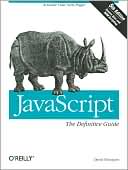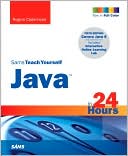Designing Active Server Pages: Scott Mitchell's Guide to Writing Reusable Code
Developers of Active Server Pages often reinvent the wheel. Their background in web design, with its separate HTML page for each viewable web page on a site, leads many ASP developers to create a distinct ASP page each time they think they need one. Often times, these pages are functionally similar. With intelligent planning, an ASP developer stands to save a great deal of time by creating reusable ASP pages. Designing Active Server Pages is tailor-made for these developers.\ There is...
Search in google:
Developers of Active Server Pages often reinvent the wheel. Their background in web design, with its separate HTML page for each viewable web page on a site, leads many ASP developers to create a distinct ASP page each time they think they need one. Often times, these pages are functionally similar. With intelligent planning, an ASP developer stands to save a great deal of time by creating reusable ASP pages. "Designing Active Server Pages" is tailor-made for these developers. There is currently a plethora of Active Server Pages books. However, the vast majority of these books are either technical references or how-to books for beginners. "Designing Active Server Pages" is written for the intermediate to advanced user. Furthermore, nearly every other book on ASP focuses on using VBScript, even though ASP supports an array of scripting languages, including JScript and PerlScript. "Designing Active Server Pages" shows how to start using these other languages. The latest version of the scripting engines (Version 5.1 for VBScript) adds new features not available before the 5.0 release. These features include class support for VBScript, and Regular Expression searching through the use of a COM object. "Designing Active Server Pages" explains why using classes in VBScript is beneficial, and demonstrates the power of regular expression searching. This book shows how to simplify the process by only requiring one ASP page to handle ALL of the Forms throughout a web site, thus reducing the amount of code one has to write. Topics include: Using various Microsoft and third-party components to enhance ASP pages Creating components using VB and/or VC++ Sample codeforperforming routine ASP tasks Techniques to allow for reusable database scripts on the database system and on ASP pages How to obtain and register third-party components, thus saving massive amounts of time by reusing someone else's code "Designing Active Server Pages" is for developers who have already mastered the basics of ASP application development and are ready to take the next logical step. It is sure to become an indispensable part of every web developer's library. Booknews Shows Active Server Pages (ASP) developers how to reuse code by looking for common functionality and by separating the presentation element of web pages from script. Covers areas including scripting blocks or code libraries, developing and using classes, maximizing ASP's language independence by using another scripting language, and creating simple COM components to encapsulate common functionality by using the Microsoft Script Component Wizard. Focus is on ASP 3.0 and VBScript 5.0+. Mitchell is cofounder of an ASP resource on the Internet. Annotation c. Book News, Inc., Portland, OR (booknews.com)
\ \ Chapter 1: Introduction\ As the Web has become a more integral part of everyday life and business, web sites have matured from small, static sites into rich, data-driven, complex applications. Several technologies, including dynamic scripting technologies, like Active Server Pages and Perl, have aided along the way, making the Web a more viable application medium. This book focuses on using Active Server Pages to quickly and easily build powerful and dynamic web sites.\ Although the server-side tools for building web sites have experienced a nice maturation, the processes used for building these sites have not. What, specifically, is Active Server Page design? What is currently wrong with ASP design? Why hasn't the art of designing ASP pages advanced? What can be done to improve ASP design? The first three questions will be answered in this chapter. The last one, however, is a meaty one; it is addressed in this chapter, and answered over the next seven chapters.\ This chapter not only addresses these questions, but also introduces functions and programming styles that will be used extensively throughout this book.\ What Is Application Design?\ Designing a single ASP page is trivial. The challenges involved in designing ASP pages arise when large web sites with hundreds of web pages are being crafted. These large web sites are, in their own rights, full-scale applications. Therefore, before we examine Active Server Page design, we will first take a step back and discuss application design. As we'll see shortly, application design is a long, arduous process, involving much more than simply punching out code.\ Imagine that you have just been assigned the task of creating a new program that will be deployed to all of the employees in your company. This program will allow the users to query a centralized database and place the results into a number of formats that correspond to various interoffice forms your company uses. What do you do first? How do you get started?\ Designing, coding, testing, and deploying an application is known as application development. Temporally, it can be viewed as the time span from when the program was first conceptualized to when its first stable version was available for use. (Of course, application development does not end with the first, stable release of a product. Rather, it continues as long as updates and enhancements of the given product are being made.) An entire branch of the computer science discipline is dedicated to studying various application-development methodologies. While there are a number of different methodologies, they all usually share a certain number of phases, which include:\ \ Design\ Coding\ Testing\ Deployment\ \ In classical software development, developers usually follow this flow, working on the application's design before moving on to writing the actual code. For example, large software companies draft very detailed plans for their software projects before a developer writes a single line of code.\ Designing for the Web\ With the Web, the design stage usually focuses on the aesthetics of the web site, such as the look and feel of each web page. This makes sense, since in the Web's earlier days, the vast majority of web sites were static, their usefulness and allure directly dependent upon their HTML design. As the Web matures, though, and web sites become more dynamic, it is important that adequate time be spent on the design of the scripts that run a site.\ Simply put, the design phase in web site development focuses too much on the layout and HTML issues and too little on the programmatic side. That's not to say that HTML design is unimportant: it is very important. The end users benefit directly from the HTML design. Imagine a site that had terrible HTML design, a site cumbersome to navigate and difficult to use. Chances are, after one visit to this site, you'd not come back.\ Script design, on the other hand, benefits the developers directly, and the end users indirectly. For example, if your dynamic web site contains robust, easy-to-update scripts, the developers will directly benefit from reduced time spent in the coding phase when a new feature needs to be added. The end users will indirectly benefit from such well-designed scripts, since the less code a developer has to write, the less buggy her code will be. Additionally, well-designed scripts require less maintenance time, making it easier to add new functionality to existing scripts. (The benefits of code reuse and robust scripts are discussed in more detail in the next section, "What's Wrong with ASP Design?") Since both HTML design and script design are important, it is essential that adequate time be spent on both.\ Since ASP pages are scripts, ASP design is the art of crafting robust, reusable code. Good design requires planning, documentation, and above all, patience. Before you begin writing code for a particular ASP page, think of what the script needs to accomplish. Is it similar to the functionality of other ASP pages on the site? Have you created a page with similar functionality in a past project? How can you build this page so that it can be easily reused in future projects?\ What's Wrong with ASP Design?\ In my consulting experience, I have found that many developers don't spend any time working on the design of their scripts. Rather, they just start coding once they have an understanding of what the web site needs to look like and what tasks it needs to accomplish.\ Such an approach is inefficient and error-prone. If no thought is dedicated to determining the design of the ASP scripts before they are actually written, then for each similar script, the developer essentially reinvents the wheel. For example, imagine the developer has four ASP scripts that need to make modifications to a database. While these scripts may not be identical, assume they all have many functional similarities. Why should the developer spend the time to create each page separately, when one generic page would do?\ There is a direct correlation between the amount of code you write and the number of bugs in your program. Typos and silly mistakes catch us all, and they occur proportionally to the amount of raw source code actually written. If we can reduce the number of total ASP scripts that need to be written by generalizing certain scripts to handle the functionality present in the previous four, we will create less buggy ASP applications.\ Furthermore, intelligent ASP script design will not only save time and bugs in our current project, but also in future projects. Once a robust module is written to handle a specific task, if that task needs to be completed in a future project, we need only reuse our existing code! With hasty design techniques, code is often written without looking toward the future...
Prefacevii1.Introduction1What Is Application Design?1What's Wrong with ASP Design?3Why Hasn't ASP Design Advanced?4What Can Be Done to Improve ASP Design?5Further Reading182.Choosing a Server-Side Scripting Language19The Popularity of VBScript19Specifying the Scripting Language20Creating ASP Pages with JScript25Creating ASP Pages with PerlScript31Creating ASP Pages with Python37Further Reading373.Exception Handling39A Bit of Terminology40Detecting When Exceptions Occur42Responding to Exceptions65Creating Custom HTTP Error Pages73Further Reading774.Regular Expressions, Classes, and Dynamic Evaluation and Execution78Using the RegExp Object79Using Object-Oriented Programming with VBScript85Using Dynamic Evaluation and Execution99Further Reading1035.Form Reuse104The Importance of Code Reuse104A Primer on Form Use106Form Validation111Creating Reusable Server-Side Form Validation Routines116Developing Reusable Form Creation Routines124The Practicality of Reuse136Further Reading1376.Database Reuse138Examining Database Usage138The Building Blocks for Creating Reusable Administration Pages140Creating Reusable Administration Pages149Further Reading2467.Using Components247COM--A Quick Overview248Lesser-Known Microsoft COM Components249Enhancing Microsoft's COM Components275Building Components276Further Reading2908.Enhancing Your Web Site with Third-Party Components291Executing DOS and Windows Applications on the Web Server with ASPExec292Obtaining Detailed Information About Your Users's Browsers296Grabbing Information from Other Web Servers303Encrypting Information309Uploading Files from the Browser to the Web Server324Why Reinvent the Wheel?335Further Reading337Index339
\ From Barnes & NobleAnyone can create one Active Server Page -- but when you're building large-scale applications with ASP, it's just plain inefficient to use yesterday's one-off techniques. You need to design your Active Server Pages, organize them for easy maintenance and reuse. Now you can -- with the one book that brings sanity to ASP development. This book covers every technique you need: dynamic server-side includes, modularization, VBScript classes, reusable administration pages, third-party components, and more.\ \ \ \ \ BooknewsShows Active Server Pages (ASP) developers how to reuse code by looking for common functionality and by separating the presentation element of web pages from script. Covers areas including scripting blocks or code libraries, developing and using classes, maximizing ASP's language independence by using another scripting language, and creating simple COM components to encapsulate common functionality by using the Microsoft Script Component Wizard. Focus is on ASP 3.0 and VBScript 5.0+. Mitchell is cofounder of an ASP resource on the Internet. Annotation c. Book News, Inc., Portland, OR (booknews.com)\ \








![Java How to Program: Early Objects Version [With CDROM] Java How to Program: Early Objects Version [With CDROM]](/application/data/covers/30/64/9780136053064.jpg)